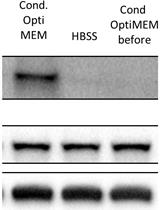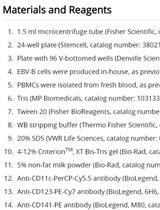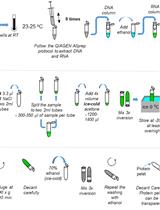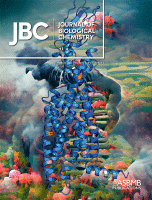- Submit a Protocol
- Receive Our Alerts
- Log in
- /
- Sign up
- My Bio Page
- Edit My Profile
- Change Password
- Log Out
- EN
- EN - English
- CN - 中文
- Protocols
- Articles and Issues
- For Authors
- About
- Become a Reviewer
- EN - English
- CN - 中文
- Home
- Protocols
- Articles and Issues
- For Authors
- About
- Become a Reviewer
Far-western Blotting Detection of the Binding of Insulin Receptor Substrate to the Insulin Receptor
Published: Vol 13, Iss 4, Feb 20, 2023 DOI: 10.21769/BioProtoc.4619 Views: 2420
Reviewed by: Suresh KumarRitu GuptaAnonymous reviewer(s)

Protocol Collections
Comprehensive collections of detailed, peer-reviewed protocols focusing on specific topics
Related protocols

Mutant Huntingtin Secretion in Neuro2A Cells and Rat Primary Cortical Neurons
Katarina Trajkovic [...] Dimitri Krainc
Jan 5, 2018 8511 Views

Measurement of CD74 N-terminal Fragment Accumulation in Cells Treated with SPPL2a Inhibitor
Rubén Martínez-Barricarte [...] Jean-Laurent Casanova
Jun 5, 2019 6921 Views

Capillary Nano-immunoassay for Quantification of Proteins from CD138-purified Myeloma Cells
Irena Misiewicz-Krzeminska [...] Norma C. Gutiérrez
Jun 20, 2019 6790 Views
Abstract
Far-western blotting, derived from the western blot, has been used to detect interactions between proteins in vitro, such as receptor–ligand interactions. The insulin signaling pathway plays a critical role in the regulation of both metabolism and cell growth. The binding of the insulin receptor substrate (IRS) to the insulin receptor is essential for the propagation of downstream signaling after the activation of the insulin receptor by insulin. Here, we describe a step-by-step far-western blotting protocol for determining the binding of IRS to the insulin receptor.
Keywords: Signal transductionBackground
Insulin, secreted by the pancreatic β-cells, is the most powerful anabolic hormone known to regulate the metabolism of glucose, lipids, and amino acid metabolism through the activation of the insulin signaling pathway. Insulin binding to the insulin receptor (IR), a tetrameric complex consisting of two extracellular α-subunits and two transmembrane β-subunits, leads to a conformational change, the activation of tyrosine kinase activity in the β-subunits, and the transphosphorylation of β-subunits at Y972 (Sweet et al., 1987; Cheatham and Kahn, 1995; Yip and Ottensmeyer, 2003). The phosphorylation of the β-subunit at Y972 generates a NPXpY motif, which the downstream mediator insulin receptor substrate (IRS) subsequently recognizes and binds to in the insulin receptor b (IRβ), resulting in the activation of PI3K-AKT signaling (Machado-Neto et al., 2018; White et al., 1988). Therefore, the binding of the IRS to the IRβ subunit plays a critical role in the activation of insulin signaling (Peng and He, 2018).
Far-western blotting is an effective technique to assess protein–protein interactions, including receptor–ligand interactions (Kaido et al., 2007; Wu et al., 2007), in in vitro assays. In a far-western blotting analysis, one protein is first separated in an SDS-PAGE gel and transferred to a membrane, followed by the binding of a non-antibody secondary protein. Then, a specific antibody against the secondary protein will be employed to determine its binding to the first protein that is being transferred onto the membrane (Figure 1). This method can be used in a regular laboratory, without the need of expensive equipment, to determine the interaction of proteins in other methods, such as the surface plasmon resonance system. We introduce a far-western blotting analysis that has been successfully used to determine the interaction of IRβ to its downstream mediator, the IRS, and to assess the importance of post-translational acetylation of IRS in affecting its binding to IRβ, as well as the activation of the insulin signaling pathway in our studies (Cao et al., 2017; Peng et al., 2022).

Figure 1. Procedure of far-western blotting to examine the binding of IRS to IRβ. A. Sequential steps of the procedure. B. Diagram depicts the detection of the binding with antibody. C. Purified IRS1 and IRS2 proteins were subjected to SDS-PAGE and stained with colloidal blue. D. Similar quantities of IRS2 and acetylated IRS2 by acetyltransferase P300 protein were employed in an SDS-PAGE and transferred onto a membrane; after renaturation, membranes were incubated with IRβ, followed by incubation with anti-IRβ antibody.
Materials and Reagents
1.5 mL Eppendorf tubes (Eppendorf, catalog number: 022363204)
Immuno-Blot PVDF membrane (Bio-Rad, catalog number: 1620177)
Tris-HCl (pH 6.8) (Sigma-Aldrich, catalog number: T5941)
Sodium dodecyl sulfate (Sigma-Aldrich, catalog number: L3771)
Glycerol (Sigma-Aldrich, catalog number: G5516)
β-mercaptoethanol (Sigma-Aldrich, catalog number: M3148)
EDTA (Sigma-Aldrich, catalog number: E9884)
Bromophenol blue (Sigma-Aldrich, catalog number: B8026)
NuPAGETM LDS sample buffer (4×) (Thermo Fisher Scientific, catalog number: NP0007)
NuPAGETM 3%–8%, NovexTM tris-acetate 1.5 mm mini protein gel, 10 well (Thermo Fisher Scientific, catalog number: EA0378BOX)
NuPAGETM tris-acetate SDS running buffer (20×) (Thermo Fisher Scientific, catalog number: LA0041)
IRS proteins were prepared as described previously (Cao et al., 2017; Peng et al., 2022). To determine the effect of IRS acetylation on its binding to IRb, IRS1 and IRS2 proteins were acetylated by acetyltransferase P300 protein. In the acetylation assay, 2 μg of IRS1 or IRS2 were added to the reaction containing 50 mM Tris-HCl (pH 8.0), 5% glycerol, 0.1 mM EDTA, 50 mM KCl, 1 mM dithiothreitol (DTT), 1 mM PMSF, 10 mM sodium butyrate, 0.2 μg of acetyl-CoA, and 0.2 μg of P300 (Active Motif). Samples were incubated at 30 °C for 1 h. In another acetylation assay set, acetyl-CoA was not added but it served as a positive control.
Recombinant human IRβ protein (Creative Biomart, catalog number: INSR-5093H)
Anti-IRβ (Cell Signaling Technology, catalog number: 3020); dilution: 1:500
Protein ladder (Thermo Fisher Scientific, catalog number: 26634)
Tris (Sigma-Aldrich, catalog number: T1503)
Glycine (Sigma-Aldrich, catalog number: G8898)
Methanol (Sigma-Aldrich, catalog number: 34860)
NaCl (Sigma-Aldrich, catalog number: 9888)
Tween-20 (Sigma-Aldrich, catalog number: P1379)
Skim milk powder (Bio-Rad, catalog number: 1706404XTU)
DTT (Sigma-Aldrich, catalog number: D0632)
KH2PO4 (Sigma-Aldrich, catalog number: P5655)
Na2HPO4 (Sigma-Aldrich, catalog number: S9763)
Guanidine-HCl (Sigma-Aldrich, catalog number: G3272)
ECL kit (PierceTM ECL western blotting substrate) (Thermo Fisher Scientific, catalog number: 32106)
Loading buffer (see Recipes)
Wet transfer buffer (see Recipes)
Denaturing and renaturing buffers (see Table 1) (see Recipes)
Protein-binding buffer (see Recipes)
PBST buffer (see Recipes)
Equipment
Mini gel tank (Thermo Fisher Scientific, catalog number: A25977)
PowerPacTM basic power supply (Bio-Rad, catalog number: 1645050)
ChemiDoc XRS+ gel imaging system (Bio-Rad)
Mini trans-blot electrophoretic transfer cell (Bio-Rad, catalog number: 1703930)
Procedure
Denaturing the protein samples
Prepare 4× loading buffer.
Mix the loading buffer (4×) and NuPAGETM LDS sample buffer (4×) in 1:1 volume.
Apply the mix to the purified protein of mouse IRS1 (0.2–0.4 μg/μL) and IRS2 (0.2–0.5 μg/μL) (final 1×) in 1.5 mL Eppendorf tubes, at 95 °C for 10 min, and put on ice right after.
Notes:
The mixture of loading buffer and NuPAGETM LDS sample buffer (final 1×) can be used as a negative control.
During the heating process, pay close attention to prevent the sample from volatilizing due to the tubes’ caps opening. Before loading the sample, collect the water vapor on the cap by completing a short spin.
Separating protein samples by electrophoresis
Load the denatured IRS1 and IRS2 protein samples onto the NovexTM mini protein gel along with the protein ladder. Run at 80 V in the stacking gel and then turn to 120–150 V in the resolving gel, until your target protein migrates to the middle of the resolving gel.
Notes:
Sample volume should not be >50 μL for a 1.5 mm 10-well gel. In our experiment, we load 5–10 μg of IRS1 (180 kD) protein and 5–12 μg of IRS2 (185 kD) protein.
When the protein samples run into the resolving gel, transfer the electrophoresis tank into the refrigerator set at 4 °C.
Based on the migration of the protein ladder, the position of the target protein in the gel can be estimated.
Transferring the protein to the membrane
Membrane preparation: pre wet the PVDF membrane first in methanol for 20 s, then place in ultrapure water for one quick rinse, followed by sitting in ultrapure water for 5 min, and finally in the wet transfer buffer (for at least 15 min).
After electrophoresis is complete, wash the electrophoresis plates with pure water, place the gel over the blotting paper, carefully place the pre wet PVDF membrane onto the gel, place a second blotting paper onto the PVDF membrane, and place a sponge support pad.
In this assay, we use wet transfer [100 V/gel, 2 h (for 1.5 mm gel), room temperature (RT)] or 10 mA/gel, overnight at 4 °C.
Caution:
To open and remove gel(s) from the pre-cast gel cassettes, please refer to the “NuPAGE Technical Guide” at https://www.thermofisher.cn/order/catalog/product/EA0375PK2.
Make sure that there are no air bubbles present in the transfer sandwich.
Denaturing/renaturing of proteins on the membrane
After the transfer is complete, take the membrane out of the sandwich and rinse with ultrapure water twice.
Incubate the membrane in the denaturing and renaturing buffers (freshly prepared) from high to low concentrations of guanidine-HCl as shown in Table 1. Finally, incubate the membrane in the denaturing and renaturing buffer without guanidine-HCl overnight at 4 °C.
Table 1. Denaturing and renaturing buffers with varying concentrations of guanidine-HCl
Guanidine-HCl concentration 6 M 3 M 1 M 0.1 M 0 M 80% glycerol (mL) 3.125 3.125 3.125 3.125 3.125 5 M NaCl (mL) 0.5 0.5 0.5 0.5 0.5 1 M Tris pH 7.5 (mL) 0.5 0.5 0.5 0.5 0.5 0.5 M EDTA (mL) 0.05 0.05 0.05 0.05 0.05 10% tween-20 (mL) 0.25 0.25 0.25 0.25 0.25 8 M guanidine-HCl (mL) 18.75 9.3 3.13 0.31 0 Milk powder (g) 0.5 0.5 0.5 0.5 0.5 1M DTT (μL) 25 25 25 25 25 ddH2O (mL) 1.825 12.195 17.445 20.265 20.575 Total volume (mL) 25 25 25 25 25 Time/temperature 30 min/RT 30 min/RT 30 min/RT 30 min/4 °C Overnight/4 °C Caution: Completely renaturing proteins on the membrane is critical for subsequent protein–protein binding assays.
Blocking the membrane with 5% milk in PBST buffer for 1 h, at RT
Incubating the membrane with recombinant human IRβ protein
After blocking, wash the membrane with PBST buffer three times for 5 min.
Apply 3–10 μg of IRβ in PBST buffer containing 3% milk and incubate with the membrane at 4 °C overnight.
Detecting the IRβ bound to IRS1/2 on the membrane
Wash off un-bound IRβ with PBST buffer three times for 10 min.
Incubate with anti-IRβ (1:250 dilution) in 3% milk PBST, at 4 °C overnight.
Wash the membrane with PBST buffer, three times for 10 min.
Incubate the membrane with the secondary antibody (1:5,000 dilution) for 1 h at RT.
Wash the membrane with PBST buffer, three times for 10 min.
Rinse the membrane with PBS for 5 min.
Developing the membrane with the chemiluminescent ECL kit according to the instructions
Briefly, prepare the chemiluminescent substrate reagent by mixing the detection reagent 1 and 2 at 1:1 volume. Incubate the blot with the chemiluminescent substrate for 2 min. Remove the blot from the substrate and place it in the ChemiDoc XRS+ gel imaging system to get image.
Caution: Use a sufficient volume to ensure that the blot is completely wet with the chemiluminescent substrate and does not become dry (0.1 mL/cm2).
Recipes
Loading buffer
50 mM Tris-HCl (pH 6.8)
2% sodium dodecyl sulfate
10% glycerol
1% β-mercaptoethanol
12.5 mM EDTA
0.02% bromophenol blue
This loading dye can be stored at RT (-20 °C) for up to six months.
Wet transfer buffer
25 mM Tris
192 mM glycine
20% methanol
The buffer should be freshly prepared.
Denaturing and renaturing buffers
100 mM NaCl
20 mM Tris (pH 7.6)
10% glycerol
0.1% Tween-20
2% skim milk powder
1 mM DTT
This should be freshly prepared.
Protein-binding buffer
100 mM NaCl
20 mM Tris (pH 7.6)
0.5 mM EDTA
10% glycerol
0.1% Tween-20
2% skim milk powder
1 mM DTT
The solution should be freshly prepared.
PBST buffer
4 mM KH2PO4
16 mM Na2HPO4
115 mM NaCl (pH 7.4)
0.05% Tween-20
Prepare 10× PBST and store at RT for up to three months. Dilute to 1× before use.
Acknowledgments
This work was supported in part by grants from the NIH: R01DK107641 and R01DK120309. This protocol was modified from a previous publication (Wu et al., 2007).
Competing interests
We declare no competing interest.
References
- Cao, J., Peng, J., An, H., He, Q., Boronina, T., Guo, S., White, M. F., Cole, P. A. and He, L. (2017). Endotoxemia-mediated activation of acetyltransferase P300 impairs insulin signaling in obesity. Nat Commun 8(1): 131.
- Cheatham, B. and Kahn, C. R. (1995). Insulin action and the insulin signaling network. Endocr Rev 16(2): 117-142.
- Kaido, M., Inoue, Y., Takeda, Y., Sugiyama, K., Takeda, A., Mori, M., Tamai, A., Meshi, T., Okuno, T. and Mise, K. (2007). Downregulation of the NbNACa1 gene encoding a movement-protein-interacting protein reduces cell-to-cell movement of Brome mosaic virus in Nicotiana benthamiana. Mol Plant Microbe Interact 20(6): 671-681.
- Machado-Neto, J. A., Fenerich, B. A., Rodrigues Alves, A. P. N., Fernandes, J. C., Scopim-Ribeiro, R., Coelho-Silva, J. L. and Traina, F. (2018). Insulin Substrate Receptor (IRS) proteins in normal and malignant hematopoiesis. Clinics 73(suppl 1): e566s.
- Peng, J. and He, L. (2018). IRS posttranslational modifications in regulating insulin signaling. J Mol Endocrinol 60(1): R1-R8.
- Peng, J., Ramatchandirin, B., Wang, Y., Pearah, A., Namachivayam, K., Wolf, R. M., Steele, K., MohanKumar, K., Yu, L., Guo, S., White, M. F., Maheshwari, A. and He, L. (2022). The P300 acetyltransferase inhibitor C646 promotes membrane translocation of insulin receptor protein substrate and interaction with the insulin receptor. J Biol Chem 298(3): 101621.
- Sweet, L. J., Morrison, B. D. and Pessin, J. E. (1987). Isolation of functional alpha beta heterodimers from the purified human placental alpha 2 beta 2 heterotetrameric insulin receptor complex. A structural basis for insulin binding heterogeneity. J Biol Chem 262(15): 6939-6942.
- White, M. F., Livingston, J. N., Backer, J. M., Lauris, V., Dull, T. J., Ullrich, A. and Kahn, C. R. (1988). Mutation of the insulin receptor at tyrosine 960 inhibits signal transmission but does not affect its tyrosine kinase activity. Cell 54(5): 641-649.
- Wu, Y., Li, Q. and Chen, X. Z. (2007). Detecting protein-protein interactions by Far western blotting. Nat Protoc 2(12): 3278-3284.
- Yip, C. C. and Ottensmeyer, P. (2003). Three-dimensional structural interactions of insulin and its receptor. J Biol Chem 278(30): 27329-27332.
Article Information
Copyright
© 2023 The Author(s); This is an open access article under the CC BY-NC license (https://creativecommons.org/licenses/by-nc/4.0/).
How to cite
Readers should cite both the Bio-protocol article and the original research article where this protocol was used:
- Peng, J., Ramatchandirin, B., Pearah, A. and He, L. (2023). Far-western Blotting Detection of the Binding of Insulin Receptor Substrate to the Insulin Receptor. Bio-protocol 13(4): e4619. DOI: 10.21769/BioProtoc.4619.
- Peng, J., Ramatchandirin, B., Wang, Y., Pearah, A., Namachivayam, K., Wolf, R. M., Steele, K., MohanKumar, K., Yu, L., Guo, S., White, M. F., Maheshwari, A. and He, L. (2022). The P300 acetyltransferase inhibitor C646 promotes membrane translocation of insulin receptor protein substrate and interaction with the insulin receptor. J Biol Chem 298(3): 101621.
Category
Biochemistry > Protein > Immunodetection > Western blot
Cell Biology > Cell signaling > Intracellular Signaling
Do you have any questions about this protocol?
Post your question to gather feedback from the community. We will also invite the authors of this article to respond.
Share
Bluesky
X
Copy link









